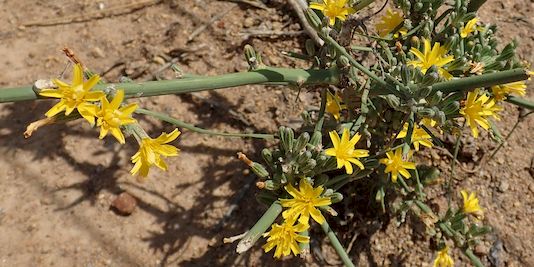Australian Plant Census (2011) available at: Vascular Plants APNI (biodiversity.org.au)
Australia's Virtual Herbarium (AVH) (2008). Council of Heads of Australian Herbaria (CHAH). Available at: Home - AVH (chah.org.au)
Baker, M. (2008) Tasmanian Herbarium, Department of Environment, Parks, Heritage and the Arts, Hobart. Personal communication.
Burbidge, N.T. & Gray, M. (1979) Flora of the Australian Capital Territory. Australian National University Press, Canberra.
Chaboudez, P., Hasan, S. & Espiau, C. (1992) Exploiting the clonal variability of Chondrilla juncea to detect virulent strains of Puccinia chondrillina for use in Australia. In R.G. Richardson (compiler), Proceedings of the First International Weed Control Congress, Monash University, Melbourne, Volume 2, pp. 118-121. Weed Science Society of Victoria Inc., Melbourne.
Cooke, D.A. (1986) Compositae (Asteraceae), in J.P. Jessop & H.R. Toelken (eds), Flora of South Australia 4th edn, Part 3, pp. 1423-1658. South Australian Government. Available on eFloraSA (Electronic Flora of South Australia species Fact Sheet) at: Fact sheet for Chondrilla juncea (flora.sa.gov.au)
Cunningham, G.M., Mulham, W.E., Milthorpe, P.L. & Leigh, J.H. (1992) Plants of Western New South Wales. Inkata Press.
Currie, G.A. (1936) A report on a survey of weed problems in Australia. CSIR Pamphlet No. 60.
Curtis, W.M. (1963) The Student's Flora of Tasmania, Part 2. L.G. Shea, Government Printer, Tasmania.
Felfoldi, E.M. (1993) Identifying the Weeds Around You. Department of Agriculture Victoria/Inkata Press.
Fletcher, R., Atkins, D. & Peirce, J. (2003) Skeleton Weed in Western Australia: Pocket Guide. Bulletin No. 4588. Western Australian Skeleton Weed Committee with the Department of Agriculture and Agriculture Protection Board.
Holm, L., Doll, J., Holm, E., Pancho, J. & Herberger, J. (1997) World Weeds. John Wiley & Sons, New York.
Hussey, B.M.J., Keighery, G.J., Cousens, R.D., Dodd, J. & Lloyd, S.G. (1997) Western Weeds. A guide to the weeds of Western Australia. The Plant Protection Society of Western Australia, Victoria Park.
Jeanes, J.A. (1999) Chondrilla, in N.G. Walsh. & T.J. Entwisle (eds), Flora of Victoria Volume 4, pp. 694-695. Inkata Press, Melbourne.
Lamp, C. & Collet, F. (1989) Field Guide to Weeds in Australia, 3rd edn. Inkata Press, Melbourne.
Lander, N.S. (1987) Asteraceae, in N.G. Marchant et al., Flora of the Perth Region, Part 2, pp. 648-714. Western Australian Herbarium.
McVean, D.N. (1966) Ecology of Chondrilla juncea L. in south-eastern Australia. Journal of Ecology 54: 345-365.
Meadly, G.R.W. (1963) Skeleton Weed. Journal of Agriculture Western Australia 4: 700-708.
Murray, L. (1992) Chondrilla, in G.J. Harden (ed.), Flora of New South Wales Volume 3, p. 336-337. New South Wales University Press, Kensington. Available on New South Wales FloraOnline at: PlantNET - FloraOnline (nsw.gov.au)
O'Neil, J.M. (1961) Which plant is Skeleton Weed? Journal of Agriculture South Australia 65: 18-22.
Panetta, F.D. & Dodd, J. (1995) Chondrilla juncea L., in R.H. Groves, R.C.H. Shepherd & R.G. Richardson (eds), The Biology of Australian Weeds Volume 1, pp. 67-86. R.G. & F.J. Richardson, Melbourne. This reference summarises many features of Skeleton Weed and includes an extensive reference list.
Parsons, W.T. & Cuthbertson, E.G. (2001) Noxious Weeds of Australia, 2nd edn. CSIRO, Collingwood.
Richardson, F.J., Richardson, R.G. & Shepherd, R.C.H. (2006) Weeds of the South-east. R.G. & F.J. Richardson, Meredith, Victoria.
Sainty & Associates (2003) Skeleton Weed Chondrilla juncea, WEEDeck card H29. Sainty and Associates, Potts Point. (Information available on Weeds Australia website, see below).
Tasmanian Department of Primary Industries and Water (2008) Weeds, Pests and Diseases - Skeleton Weed Chondrilla juncea L. - Statutory Weed Management Plan. Available (updated) at: Skeleton-weed_WMP_2011.pdf (nre.tas.gov.au) [pdf link]
Thorp, J.R. & Wilson, M. (1998 - ). Weed Identification - Skeleton Weed. Australian Weeds Committee.
Victorian Department of Primary Industries (2008) Victorian Resources Online: Skeleton Weed (Chondrilla juncea). Available at: Skeleton weed (Chondrilla juncea) (Nox) | VRO | Agriculture Victoria Potential distribution of Skeleton Weed in Victoria available at: Potential Distribution of Skeleton weed (Chondrilla juncea) in Victoria (Nox) | VRO | Agriculture Victoria
Weeds Australia (undated) Weed Identification - Skeleton Weed Chondrilla juncea.
Western Australian Department of Agriculture and Food (2005a) Skeleton Weed (Chondrilla juncea) - ecology and distribution. Available (updated) at: Skeleton weed | Agriculture and Food
Western Australian Department of Agriculture and Food (2005b) Modifications to the recommendations for Skeleton Weed treatment in paddocks.
Western Australian Department of Agriculture and Food (2006) A Guide for Skeleton Weed Management and Control. Bulletin No. 4693. Available at: A guide for skeleton weed management and control (dpird.wa.gov.au) [pdf link]
Western Australian Department of Agriculture and Food (2007a) Skeleton Weed - Best Practice Management Guidelines for Cropping Areas. Bulletin 4557. Available at: https://library.dpird.wa.gov.au/cgi/viewcontent.cgi?article=1216&context=bulletins [pdf link]
Western Australian Department of Agriculture and Food (2007b) Skeleton Weed (Chondrilla juncea L.) control in Western Australia.
Western Australian Department of Agriculture and Food (2007c) Chemical Control of Skeleton Weed (Chondrilla juncea) Information Sheet. Available (updated) at: Skeleton weed: chemical control | Agriculture and Food
Western Australian Department of Agriculture and Food (2007d) Skeleton Weed - summer treatments.
Western Australian Department of Agriculture and Food (undated) Declared plant in Western Australia: Skeleton Weed (Chondrilla juncea). Available (updated) at: Skeleton weed: declared pest | Agriculture and Food
Western Australian Herbarium (2007) Chondrilla juncea L. - Skeleton Weed, in FloraBase - The Western Australian Flora. Department of Environment and Conservation. Available at: Taxon Profile of Chondrilla juncea L. | Florabase (dbca.wa.gov.au)
Agriculture Victoria (2021). Skeleton weed (Chondrilla juncea). Victorian Resources Online, Victoria State Government. Available at: Skeleton weed (Chondrilla juncea) (Nox) | VRO | Agriculture Victoria
CABI. (2021). Chondrilla juncea (rush skeletonweed). In: Invasive Species Compendium. Wallingford, UK: CAB International. Available at: Chondrilla juncea (rush skeletonweed) | CABI Compendium (cabidigitallibrary.org)
Government of South Australia (2015). Plant Policy, Oni Skeleton Weed (Chondrilla juncea). South Australia. Available at: Proclaimed Plant Policy (pir.sa.gov.au)
HerbiGuide (2021). Skeleton weed Chondrilla juncea L. HerbiGuide. Available at: Skeleton weed (herbiguide.com.au)
VicFlora (2016). Flora of Victoria, Royal Botanic Gardens Victoria, Available at: VicFlora: Chondrilla juncea (rbg.vic.gov.au)































